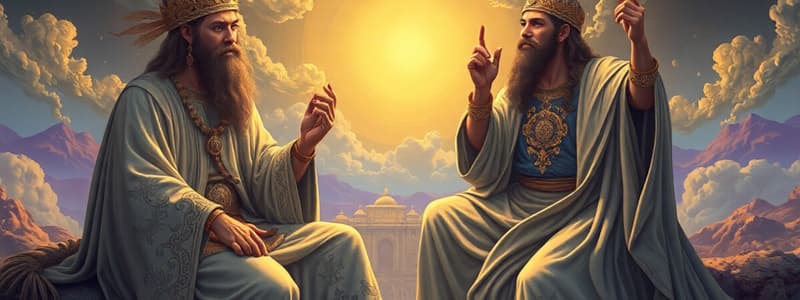Podcast
Questions and Answers
The Book of Isaiah is traditionally considered to be a book penned by the prophet Isaiah.
The Book of Isaiah is traditionally considered to be a book penned by the prophet Isaiah.
True (A)
Even in the 12th century, Jewish commentator Ibn Ezra expressed doubts regarding the unity of the Book of Isaiah.
Even in the 12th century, Jewish commentator Ibn Ezra expressed doubts regarding the unity of the Book of Isaiah.
True (A)
Who is credited with definitively observing that chapters 40-66 of the Book of Isaiah are independent works?
Who is credited with definitively observing that chapters 40-66 of the Book of Isaiah are independent works?
J.C. Döderlein
Who further divided chapters 40-66 of the Book of Isaiah into two works?
Who further divided chapters 40-66 of the Book of Isaiah into two works?
Isaiah 40-55 contains superscriptions indicating the time and place of its writing.
Isaiah 40-55 contains superscriptions indicating the time and place of its writing.
The style and mood of Isaiah 40-55 are similar to the earlier chapters of Isaiah.
The style and mood of Isaiah 40-55 are similar to the earlier chapters of Isaiah.
The presence of the name Cyrus in Isaiah 40-55 strengthens the case for a unified authorship of the entire book.
The presence of the name Cyrus in Isaiah 40-55 strengthens the case for a unified authorship of the entire book.
Which of the following is NOT a key argument for the distinct authorship of Isaiah 40-55?
Which of the following is NOT a key argument for the distinct authorship of Isaiah 40-55?
The ‘new exodus' envisioned in Isaiah 40-55 refers to the return of the Israelites from exile in Babylon to the Promised Land.
The ‘new exodus' envisioned in Isaiah 40-55 refers to the return of the Israelites from exile in Babylon to the Promised Land.
This new exodus is portrayed as an event that will happen quickly.
This new exodus is portrayed as an event that will happen quickly.
Second-Isaiah considers the Persian king Cyrus to be YHWH's shepherd.
Second-Isaiah considers the Persian king Cyrus to be YHWH's shepherd.
The ‘political' and ‘theological’ are considered separate entities in Second-Isaiah's portrayal of salvation.
The ‘political' and ‘theological’ are considered separate entities in Second-Isaiah's portrayal of salvation.
The message of hope found in Isaiah 40-55 is primarily directed towards the Israelites living in exile in Babylon.
The message of hope found in Isaiah 40-55 is primarily directed towards the Israelites living in exile in Babylon.
Second-Isaiah argues that the people of God are inherently unable to hear or see the truth.
Second-Isaiah argues that the people of God are inherently unable to hear or see the truth.
The Israelites in exile had been more receptive to Isaiah 40-55 than they had been to the earlier prophecies of Isaiah.
The Israelites in exile had been more receptive to Isaiah 40-55 than they had been to the earlier prophecies of Isaiah.
Second-Isaiah confronts the issue of foreign faiths by defending YHWH’s exclusive claim to power and authority.
Second-Isaiah confronts the issue of foreign faiths by defending YHWH’s exclusive claim to power and authority.
Second-Isaiah emphasizes that true God is characterized by his spoken word, the accurate declaration of past and future events.
Second-Isaiah emphasizes that true God is characterized by his spoken word, the accurate declaration of past and future events.
Second-Isaiah believes that the Israelites' understanding of God is monotheistic, meaning the only true God is YHWH.
Second-Isaiah believes that the Israelites' understanding of God is monotheistic, meaning the only true God is YHWH.
According to Schmidt, the passages from Second-Isaiah do not rule out the existence of other gods.
According to Schmidt, the passages from Second-Isaiah do not rule out the existence of other gods.
Second-Isaiah seeks to demonstrate the superiority of YHWH by contrasting him with the caricature of foreign deities.
Second-Isaiah seeks to demonstrate the superiority of YHWH by contrasting him with the caricature of foreign deities.
The four servant poems in Isaiah each focus on a distinct and separate theme.
The four servant poems in Isaiah each focus on a distinct and separate theme.
What are the four servant poems?
What are the four servant poems?
Which of the following is NOT a possible interpretation of the Servant of YHWH in the four servant poems?
Which of the following is NOT a possible interpretation of the Servant of YHWH in the four servant poems?
The individual interpretation of the servant suggests that the servant is a unique individual who is not a representation of Israel as a whole or a historical figure.
The individual interpretation of the servant suggests that the servant is a unique individual who is not a representation of Israel as a whole or a historical figure.
Second-Isaiah holds the view that the Israelites were a ‘deaf and blind’ people because of their rejection of the servant.
Second-Isaiah holds the view that the Israelites were a ‘deaf and blind’ people because of their rejection of the servant.
Schmidt argues that the servant’s willingness to accept his fate distinguishes him from the ‘deaf and blind’ people.
Schmidt argues that the servant’s willingness to accept his fate distinguishes him from the ‘deaf and blind’ people.
Second-Isaiah’s belief in the power of the first commandment highlights his emphasis on the importance of monotheism.
Second-Isaiah’s belief in the power of the first commandment highlights his emphasis on the importance of monotheism.
The text suggests that the people of God are called to be ‘messengers’ and ‘witnesses’ to the world.
The text suggests that the people of God are called to be ‘messengers’ and ‘witnesses’ to the world.
Second-Isaiah advocates for the inclusion of non-Israelites into the people of God through the ‘addition’ rather than the ‘replacement’ of Israelites.
Second-Isaiah advocates for the inclusion of non-Israelites into the people of God through the ‘addition’ rather than the ‘replacement’ of Israelites.
The suffering servant in Isaiah 40-55 is a figure from the past who is revered as a source of redemption.
The suffering servant in Isaiah 40-55 is a figure from the past who is revered as a source of redemption.
The tradition of the innocent sufferer is connected to the notion of vicarious suffering for the sins of others.
The tradition of the innocent sufferer is connected to the notion of vicarious suffering for the sins of others.
The servant's sacrifice is seen as a way to reconcile God and humanity through the forgiveness of sins.
The servant's sacrifice is seen as a way to reconcile God and humanity through the forgiveness of sins.
The servant's suffering is portrayed as a unique and powerful form of atonement distinct from other methods like repentance or sacrifice.
The servant's suffering is portrayed as a unique and powerful form of atonement distinct from other methods like repentance or sacrifice.
Christian theology views Jesus as the suffering servant who bridges the gap between God and humanity, providing atonement for sin.
Christian theology views Jesus as the suffering servant who bridges the gap between God and humanity, providing atonement for sin.
The term ‘redeemer’ in the book of Leviticus signifies liberation of property from an incurred charge.
The term ‘redeemer’ in the book of Leviticus signifies liberation of property from an incurred charge.
Second-Isaiah applies the concept of ‘redeemer’ to God, showcasing His role as the ultimate liberator of the Israelites from bondage and exile.
Second-Isaiah applies the concept of ‘redeemer’ to God, showcasing His role as the ultimate liberator of the Israelites from bondage and exile.
In Christian theology, Jesus is seen as the ultimate redeemer, fulfilling the prophecy of the suffering servant by conquering evil and offering salvation to humanity.
In Christian theology, Jesus is seen as the ultimate redeemer, fulfilling the prophecy of the suffering servant by conquering evil and offering salvation to humanity.
The suffering servant in Isaiah 40-55 is a historical figure from the past, such as Moses or Jeremiah.
The suffering servant in Isaiah 40-55 is a historical figure from the past, such as Moses or Jeremiah.
The autobiographical interpretation of the servant suggests that the author of Isaiah 40-55 is the one who embodies the servant’s characteristics and mission.
The autobiographical interpretation of the servant suggests that the author of Isaiah 40-55 is the one who embodies the servant’s characteristics and mission.
Second-Isaiah’s focus on the innocence of the servant highlights the notion that his suffering is undeserved, yet crucial for the atonement of sin.
Second-Isaiah’s focus on the innocence of the servant highlights the notion that his suffering is undeserved, yet crucial for the atonement of sin.
Flashcards
Second Isaiah
Second Isaiah
The section of the Book of Isaiah (chapters 40-55) attributed to a different author than the first Isaiah, who lived during the Babylonian exile.
Babylonian exile
Babylonian exile
The period when the Israelites were taken captive and held in Babylon.
Cyrus the Great
Cyrus the Great
The Persian king mentioned in Isaiah 40-55, seen as an instrument of God's plan for the Jews' return to Jerusalem.
New Exodus
New Exodus
Signup and view all the flashcards
Monotheism
Monotheism
Signup and view all the flashcards
Deutero-Isaiah
Deutero-Isaiah
Signup and view all the flashcards
The Cyrus Cylinder
The Cyrus Cylinder
Signup and view all the flashcards
Oracles of Hope for Babylonian Exiles
Oracles of Hope for Babylonian Exiles
Signup and view all the flashcards
Oracles of Restoration for the Nation
Oracles of Restoration for the Nation
Signup and view all the flashcards
Study Notes
Second Isaiah (40-55)
- Traditionally, the Book of Isaiah was considered one book by one author.
- Modern criticism questioned the authorship and date of writing, beginning in the late 18th century.
- Chapter 40-66 are independent works of an author who lived towards the end of the Babylonian exile
- Further study of chapters 40-66 reveals two works.
Authorship and Historical Background
- Isaiah 40-55 has no explicit time/place information
- Second Isaiah's ministry is inferred from the content of the book.
- The book demonstrates a distinct writing style and mood
- The book is unified, although seemingly unrelated to the earlier prophecies of Isaiah.
- Evidence for this unity includes the appearance of Cyrus (44:28; 45:1) in the text.
- Cyrus the Great, the Persian king, was a key figure in the 6th century, around the time of the Babylonian exile.
- The time period of the content of 40-55 aligns more closely with the 6th century exile than the 8th century.
- The theology in Second Isaiah strongly aligns with other 6th-century Old Testament writings
Outline of Deutero-Isaiah
- Oracles of Hope for Babylonian Exiles (40-48)
- Oracles of Restoration for the Nation (49-55)
Studying That Suits You
Use AI to generate personalized quizzes and flashcards to suit your learning preferences.




